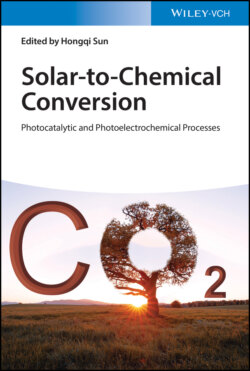Читать книгу Solar-to-Chemical Conversion - Группа авторов - Страница 32
3.2 Overview of Natural Photosynthesis
ОглавлениеThe molecular processes of natural photosynthesis can be distinguished into light‐dependent and light‐independent processes (occasionally referred to, somewhat misleadingly, as the “light” and “dark” reactions) [4]. In oxygenic photosynthesis by plants, algae, and cyanobacteria, the light‐dependent reactions involve splitting of water and transfer of reducing equivalents to nicotinamide adenine dinucleotide phosphate (NADP+) for the production of NADPH, coupled with chemiosmotic production of adenosine triphosphate (ATP), while the light‐independent processes involve the carbon fixation reactions (CO2 reduction). The overall transformation effected by the light‐dependent photosynthetic reactions can be summarized as
(3.1)
Figure 3.2 depicts the main enzymatic components of oxygenic photosynthesis. These are arranged in membranes, which for plants are the thylakoid membranes within chloroplasts. The process begins at the photosystem II (PS‐II). Light is harvested by many chlorophyll molecules arranged in “antennae,” proteins attached to the photosystems and evolved to combine light absorption with efficient excitation energy transfer at the charge separation centers. These contain specially arranged sets of closely coupled chlorophyll and pheophytin molecules where excitation induces electron transfer from one chromophore to another. Charge separation in PS‐II results in creation of the strongest oxidant known in biology (estimated reduction potential of c. +1.2 eV) [19], at a group of chlorophylls designated as P680. This charge separation drives the oxidation of water into dioxygen, protons, and electrons. Four‐electron water oxidation takes place at an active site called the oxygen‐evolving complex (OEC) that contains an evolutionary unique Mn4Ca cluster. PS‐II couples this process with the two‐electron reduction of a plastoquinone molecule:
(3.2)
(3.3)
Figure 3.2 Schematic membrane arrangement of enzymes involved in the light‐dependent reactions of oxygenic photosynthesis. Red arrows indicate the flow of electrons from the primary electron donor H2O to the final electron acceptor NADP+ aided by photoexcitation in photosystems II and I. Electron flow is tied to proton translocation across the membrane. The proton gradient created by accumulation of protons in the interior of the membrane powers the synthesis of ATP.
The reduced plastoquinone functions as a mobile electron carrier, transferring reducing equivalents from PS‐II to the cytochrome b6f complex. From there, another mobile carrier, the blue copper protein plastocyanin (PC), delivers electrons to photosystem I (PS‐I). A second light absorption/charge separation event at PS‐I, at a chlorophyll reaction center known as P700, promotes the electrons through chlorophylls (A0), quinones (A1), and a series of Fe–S centers (denoted FX, FA, and FB) to ferredoxin (Fd) and finally to ferredoxin–NADP reductase (FNR), which catalyzes the formation of NADPH. NADPH functions as the carrier of hydrogen to be used in CO2 fixation. The flow of electrons depicted in Figure 3.2 is coupled to generation of a proton gradient across the membrane that drives the synthesis of energy‐rich ATP molecules by ATP synthase.
Photosynthesis can be viewed as consisting of four “working modules” [20]: the first module corresponds to a light‐harvesting setup that funnels excitation energy to the second module, the charge‐separating reaction center. Charge separation drives the transfer of electrons from an oxidative module (in oxygenic photosynthesis, the OEC) to a reducing module. In natural photosynthesis the Calvin–Benson cycle is used to reduce CO2 to carbohydrates [4]. This part of natural photosynthesis, i.e. the light‐independent CO2 fixation reactions, will be discussed in a later section of this chapter. From the perspective of bioinspired artificial photosynthesis, the light‐dependent reactions discussed above are a sufficient blueprint. Further mimicking the complete network of biological processes that culminates in synthesis of carbohydrates is not a strict requirement, although its study is certain to yield valuable insights and inspiration. The successful solar‐driven generation of reducing equivalents by artificial means would already represent a complete achievement: the “reducing module” endpoint of an artificial photosynthetic system could as well involve the production of H2 as solar fuel itself, or the utilization of reducing equivalents for other chemical transformations that are technologically important but do not directly mimic the CO2 fixation reactions of natural photosynthesis. For this reason, emphasis will be placed in the following on the finer details of the light‐dependent processes outlined above.
